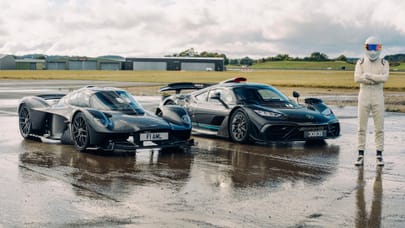
James May on engines
The remarkable thing about the new Merc S-Class, as we discussed on Top Gear TV the other day, is that for all its technological advances – its infra-red headlights, the accident avoidance technologies, the multiple massage seats – it’s still powered by essentially the same means that were used to propel Benz’s original Motorwagen of 1898.
I realise that the internal combustion piston engine has come a long way in the last century – the earliest ones were hideously inefficient and dirty by our standards, slow running, difficult to start (most people had a man for that) and, if it did start, fiendishly hard to manage – but what’s really amazing is that it’s still with us at all.
It strikes me that the fundamentals of the piston engine – which haven’t changed one bit – must be anathema to the purist engineer. It is dependent on reciprocating motion, which is always problematic, and consumes much of the power it develops in its own operation. There are camshafts to be rotated, valve springs to be compressed, coolant and oil pumps to be driven, electrical sparks to be generated. I’m sitting here looking at a cutaway drawing of a Porsche flat six, and I’m amazed how little of the mechanism is directly related to driving the car. The rest is devoted, as management types would say, to making it happen.
A jet engine is so much better, since everything rotates smoothly and efficiently around a central shaft. And yet, despite a few dramatic attempts, the gas turbine has never given us a quantum leap in car performance in the way that it has for planes.
War must have a lot to do with this, since it tends to encourage advances in aviation while leaving cars up on bricks owing to fuel shortages. The driver of a 1930s Bentley could drive the new Continental Flying Spur, once he’d got over the shock of discovering that the gearlever is indoors. The pilot of a Hawker Hurricane wouldn’t even know which way to face in the Eurofighter. Then compare the performance improvements of both: the car’s would be expressed in percentages, but the aeroplane’s in multiples.
So the engine in your car is beginning to look a bit rubbish, really. Everything else has moved on. Aeroplanes have gas turbines; ships have gas turbines and nuclear reactors; railways have had diesel electric, diesel hydraulic, turbines, pure electric and maglev. I know we now have hybrid cars, but let’s not kid ourselves about these: they are still driven entirely by petrol or diesel, and the electric motor and its associated systems are merely there in an attempt to recoup some of the energy the piston engine so famously wastes.
Think about this. The most important industry in the world, the purveyors of the most expensive consumer artefact most of us ever buy, the ambassador for nations, the motor industry; still fobbing you off with lumps of metal flapping about in holes inside other great big lumps of metal. We ought to be pretty cross about it.
However, I’ve decided that I’m delighted.
I’ve been thinking about engines quite a bit over the last few weeks and it has to be acknowledged that it’s the deficiencies of the technology that makes it exciting. There has never been a great car with a dull engine, because the engine, as Ferrari is keen to point out, is the soul of the car.
Top Gear
Newsletter
Thank you for subscribing to our newsletter. Look out for your regular round-up of news, reviews and offers in your inbox.
Get all the latest news, reviews and exclusives, direct to your inbox.
Imagine a perfect petrol engine, with absolutely linear responses, a smooth torque curve, an even sound throughout the rev range. How boring would that be? We look at graphs of engine output and tut at troughs in the torque, but let’s be honest: this is the sort of thing that makes it interesting.
Even the least mechanically sympathetic driver is intimately in tune with the workings of the engine: when it’s labouring, when it’s straining. This is a vital part of the feedback at the man/machine interface and as crucial as steering feel to the sort of people who really enjoy driving.
A few cars I’ve driven in the last week or so stand as a perfect illustration of what I’m talking about: a Porsche Boxster, my old Bentley, and Hammond’s knackered 1275cc MG Midget. These three are about as disparate as you could get, yet all offer an opportunity to delight in the piston engine.
The Midget, for example, has a pretty woeful old lump under its shuddering bonnet. It offers nothing at low revs and runs out of puff suddenly, and just before you expect it to. But this is something you recognise within a few miles of driving, and life beyond that point is a hilarious game of hunting down that fleeting period of the engine’s operating range when it comes ‘on the cam’ and keeps the little box bowling along. It’s everything a milk float isn’t, despite a similar performance envelope.
The 3.2 flat six in the new Boxster S is a much more sophisticated affair, in the pursuit of that theoretically perfect motor mentioned above. But, of course, it will never actually get there, which means that there’s a sweet spot in the engine, at about 4,000rpm and under load, when its workings translate to a curious tingle in the base of the spine. This is felt on driving out of a well executed corner and is as consummately satisfying as ejaculation.
The Bentley? Hardly a thrilling powerplant in the accepted sense. And yet… that great swelling of torque as you pull away, and the distant aristocratic harrumph from the bowels of the thing; these serve to remind you that you are ministering to a mass of whirling ironmongery fuelled by countless explosions, flawed but magical.
Oh – just remembered: I’ve driven one other car recently, a fuel-cell Vauxhall Zafira, a true electric car with its own on-board power station. The technology works brilliantly, and in time it could be made cheaply, since it’s simple and simple to use: no gearbox, no stalling, no cussed torque characteristics. Just press the pedal and go on your way with a faint whine, quietly, cleanly and efficiently. This is almost certainly the future, and I have only one complaint about it.
God in heaven, it’s boring.
Trending this week
- Car Review
Honda Civic eHEV








